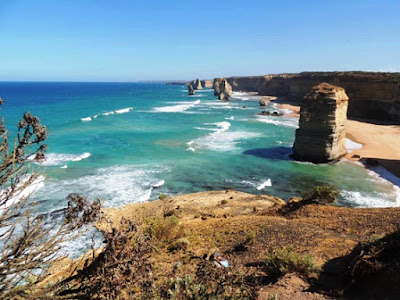 |
| Some folks were travelling in style but it wasn't us |
We took the Princess Highway which skirts along the length of the Coorong National Park. We anticipated some pretty spectacular scenery along our route but, sadly, there wasn't any to be had. According to National Parks, SA website, the Park stretches about 130 kms, protecting a string of saltwater lagoons which are protected by sweeping sand dunes. Perhaps because we were there during a drought, we saw little in the way of anything but a poker straight road (I suspect the only one on the continent #joking), salt flats and scrub brush. I tell you this, not to discourage you from taking this route, but to encourage you to make a plan. . . and we didn't have one. My best guess is, one needed to get off the beaten track a bit further in order to experience those spectacular views and we simply didn't have the time. So on we went. . . . To Kingston!
 |
| In our mind's eye, this is what we expected to see. . . Coorong National Park, looking pretty darn spectacular Photo courtesy of Shane Reid, National Parks, SA |
 |
| Instead, we found this |
 |
| Larry the Lobster, Kingston SE, SA |
 |
| Umpherston Sinkhole |
 |
| Hotel Bentinck (formerly Mac's Hotel) |
 |
| The Grotto |
There are a few 'must see' areas along this glorious stretch of water, including the Grotto, London Arch and the Twelve Apostles. No one seems to know why the Twelve Apostles are named as such but early charts refer to it as the Sow and Piglets, with the Sow being Mutton Bird Island, viewable from Loch Ard Gorge, and the piglets being the surrounding rock formations to the east.
 |
| The Breathtaking Twelve Apostles |
Although the beauty of the Great Ocean Road is undeniable, this rugged coast is also steeped in a history of terrible shipwrecks and colonial struggles, with the most infamous being the story of survival from the wreck of Loch Ard, where only two people survived: a ship's apprentice and a female passenger. The apprentice dragged the barely conscious woman into a cave and then climbed the cliff to find help. Having lost her entire family in the wreck (the grave site is located near Port Campbell), suffice to say the woman was haunted by her memories of this tragedy for the rest of her days.
 |
| Port Queencliff |
An area of Victoria that I suspect is often missed by tourists is the Bellarine Peninsula, in particular, Queenscliff, in southern Victoria. With a population of less than 1,500, and originally a fishing village, Queenscliff is a former seaside resort dating back to the 1800s. Two hours from Melbourne by steam paddler, and with increased tourism as a result of the extension of a railway from Geelong, Queenscliff once boasted numerous luxury hotels (known as coffee palaces), all the while maintaining its status as an important cargo port. It also played an important military role with the construction of Fort Queenscliff, now an historical museum.
Perhaps now you understand how we successfully managed to turn a 13-hour drive into a 5 day road trip and, honestly, it wasn't near enough time. While I had visions of kicking back and spending a a day here or there in any one of a number of lovely communities (Lorne was a favourite, by the way), we spent so much time stopping and looking, we gave up that opportunity. Next time.
Meanwhile, get ready for the next installment of our Australia travels, as we get ready to explore Tasmania.
Resources:
http://www.environment.sa.gov.au/parks/Find_a_Park/Browse_by_region/Limestone_Coast/Coorong_National_Park
http://www.kingstonse.com.au/
http://www.mountgambier.sa.gov.au
https://en.wikipedia.org/wiki/Portland,_Victoria
http://www.standard.net.au/story/796318/tragedy-haunted-loch-ard-shipwreck-survivor/
https://en.wikipedia.org/wiki/Queenscliff,_Victoria

























